|
|
|
|
|
|
|
Achi-Kochi Japan
Showing many places to visit and foods to eat in Japan
|
|
|
|
|
|
|
|
|
|
|
|
|
Japan
> Kinki region
> Himeji City, Hyogo Prefecture
|
|
|
|
|
|
|
Himeji City
Hyogo, Kinki ( Achi-Kochi Japan )
|
|
|
|
|
|
|
|
|
|
|
|
|
( "Achi-Kochi" in Japanese means "Here and there" in English. )
Himeji City

Himeji ( above ) is the second largest city in Hyogo Prefecture, located in the west of Kinki Region. Its population is more than half a million. In Himeji City, one of the most beautiful castles, Japanese style gardens and an old temple on the top of the mountain are popular among tourists.
|
|
Himeji-jo Castle

The north exit of JR ( Japan Railway ) Himeji Station is named "Himeji-jo Exit". Upon getting out of the station through the Himeji-jo Exit, tourists would find one of the most beautiful castles ( above ).
On 3rd July 1945, more than one hundred aircrafts flew over Himeji City to drop several hundreds tons of bomb. So lots of buildings were destroyed but Himeji-jo Castle miraculously, while Nagoya-jo Castle was destroyed on 14th May 1945 by air raid and Hiroshima-jo Castle was destroyed on 6th August 1945 by the atomic bomb.
Now Himeji-jo Castle, having been surviving since A.D.1609, is one of designated National Treasures of Japan and one of UNESCO World Heritage Sites. Lots of tourists visit the city to see the castle.
|
|
Main Keep of Himeji-jo Castle
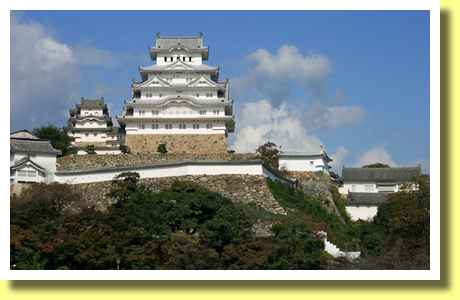
Looking up at the main keep ( above ) of Himeji-jo Castle, tourists could understand why it is called "Shirasagi-jo Castle". "Shirasagi" in Japanese means white heron. By the way Matsumoto-jo Castle, which is as beautiful as Himeji-jo Castle, is called "Karasu-jo Castle". "Karasu" means "crow".
|
|
Hishi-mon ( gate )
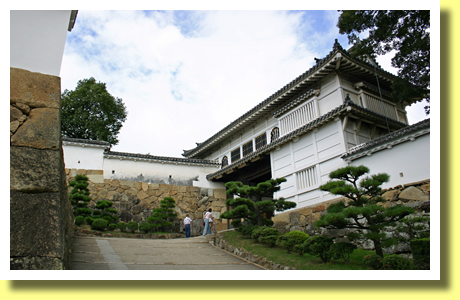
Visitors, who would like to enter the main keep, are to go through Hishi-mon ( gate - above ) from San-no-maru ( the third bailey ) after paying admission. Hishi-mon is one of the gates surviving for hundreds years.
|
|
Mazy Paths
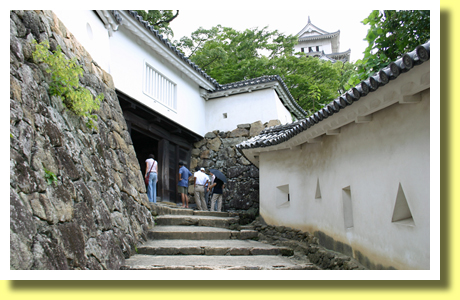
Visitors are to walk up from Hishi-mon gate to the main keep along mazy paths ( above ) surrounded by stone walls through a certain numbers of gates. Soldiers, attacking the castle, would encounter lots of difficulties while walking up the paths, though no force had attacked Himeji-jo Castle since built in A.D.1609.
|
|
Looking up at the main keep
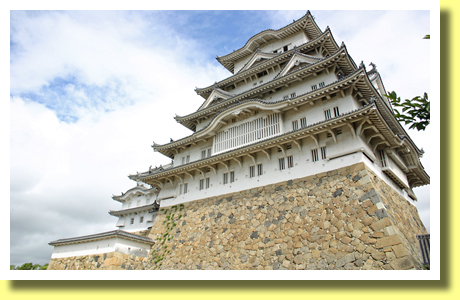
Mazy paths lead visitors to the main keep ( above ), which is a six-storey structure. It is said that here used to be a fortress since the 14th century. Hideyoshi Toyotomi, who unified Japan in A.D.1590, built the three-storey main keep in A.D.1581.
Ieyasu Tokugawa, who established Tokugawa Shogunate in A.D.1603, made Terumasa Ikeda the feudal lord of Harima Province in A.D.1600. Terumasa Ikeda enlarged Himeji-jo castle and built the six-storey main keep, which has survived for over 400 years.
|
|
Inside the main keep
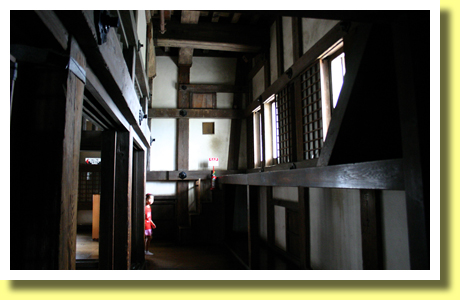
Visitors could walk around inside the main keep ( above ), where swords, armour and matchlocks are exhibited. Visitors are to climb up the steep and narrow stairs to the top floor of the main keep.
|
|
Top floor of the main keep
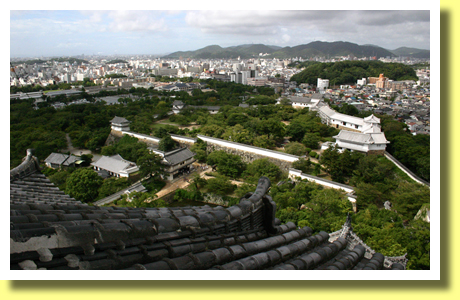
The top floor of the main keep overlooks several baileys, of which Himeji-jo Castle consists. The above photo shows Nishi-no-maru ( West Bailey ), which was completed in A.D.1618.
|
|
Nishi-no-maru ( West Bailey )
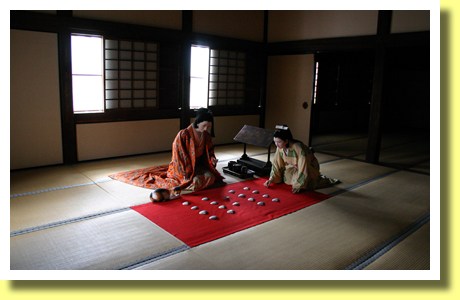
In Nishi-no-maru ( West Bailey ) there remain some buildings, one of which is Kesho-yagura ( above ). The construction costs related to the buildings in Nishi-no-maru were covered by the marriage portion, which brought to Tadatoki Honda in A.D.1616 by Sen-hime ( Lady Sen ).
Ieyasu Tokugawa, who established Tokugawa Shogunate, made his granddaughter Sen-hime married to Hideyori Toyotomi in A.D.1603 when she was 7 years old. However her husband was defeated by her grandfather and the Toyotomi lineage was terminated in A.D.1615, while she was rescued out of Osaka-jo Castle. ( ==> A History of Japan vol.2 Samurai Age )
In the following year, her father and the 2nd shogun of Tokugawa Shogunate, Hidetada Tokugawa made Sen-hime remarried to Tadatoki Honda and gave her father-in-law Himeji-jo Castle and the fief. Sen-hime lived in Nishi-no-maru ( West Bailey ) of the castle.
After her husband Tadatoki Honda died in A.D.1626, she became a Buddhist nun and lived in Edo ( Tokyo now ) until she died in A.D.1666.
|
|
Night View

Every evening, the castle is lit up ( above ). On the way to the restaurants for dinner, tourists could walk around to enjoy viewing the beautiful night view of Shirasagi ( white heron )-jo Castle.
|
|
Koko-en ( gardens )
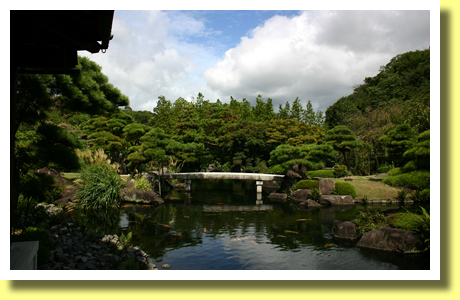
Koko-en, Japanese style gardens ( above ), is located next to Himeji-jo Castle and in the site where used to be many samurai residences including the residence of Tadamasa Honda, the feudal lord and father-in-law of Sen-hime ( Lady Sen ) built in A.D.1618.
In Koko-en, there are nine gardens, one of which is the reconstructed garden of the residence where Tadamasa Honda lived in the early 17th century. There are gardens featuring pond, waterfall, flower, pine tree, bamboo and so on. Also there are a restaurant and a tea house where visitors could enjoy lunch and/or tea while viewing the garden and the castle.
|
|
Shosha-zan and Engyo-ji
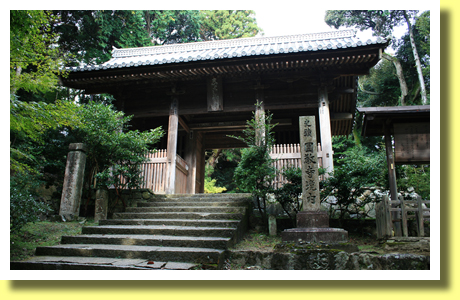
Tourists, who like walking in the historical atomosphere surrounded by forests, could be recommended to visit Engyo-ji temple located on the top of Shosha-zan mountain. It takes less than an hour from JR Himeji Station by bus and ropeway and 15 minute walk to Nio-mon gate ( above ) of the temple. Nio-mon gate was reconstructed in A.D.1617 while Engyo-ji was founded in A.D.966.
|
|
Mani-den, main hall of Engyo-ji
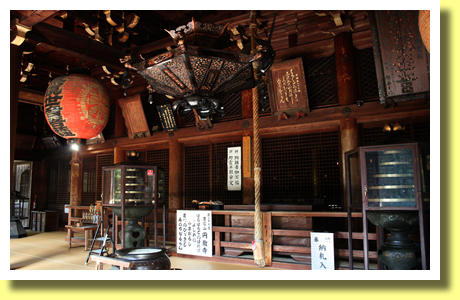
There is the temple main hall named "Mani-den" 15 minute walk from Nio-mon. Mani-den was burnt down in A.D.1921 and reconstructed on a steep slope in the traditional cascading architecture style in A.D.1933. Mani-den houses several Buddhist statues including four of designated National Important Cultural Properties of Japan. They are open to the public just on 18th January.
|
|
Jiki-do and Dai-kodo
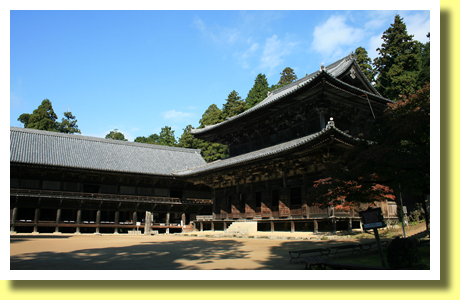
Mitsu-no-do ( three temple buildings ) consist of Dai-kodo ( large hall - above right ), Jiki-do ( dormitory and dining hall - above left ) and Jogyo-do. Mitsu-no-do had been destroyed by lightning in A.D.1331 and by fire in A.D.1436 and three buildings were reconstructed in the 15th century. Both buildings are designated National Important Cultural Properties of Japan.
|
|
Jogyo-do and Jiki-do
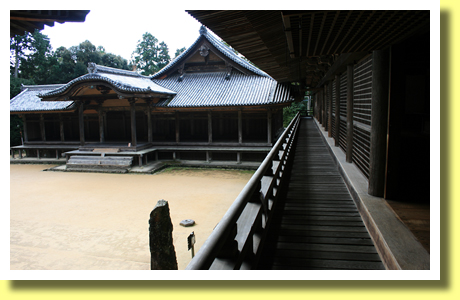
Jogyo-do ( above left ) is also one of the designated National Important Cultural Properties of Japan as well as Jiki-do ( above right ) is. Jogyo-do was reconstructed in A.D.1453 after burnt down in A.D.1436.
Engyo-ji temple is located on the top of Shosha-zan mountain surrounded by forests and there is no modern buildings nearby. So some histrcal movies and TV dramas were filmed here including the movie "The Last Samurai".
|
|
Statue of Shoku Shonin
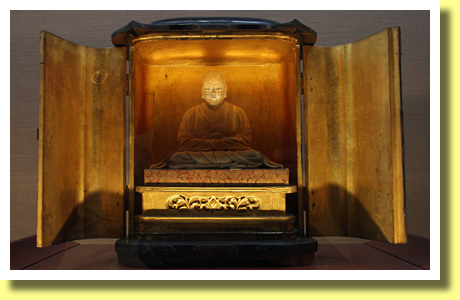
In Jiki-do, visitors would see many Buddhist statues, one of which is the statue of Shoku Shonin ( Priest Shoku - above ), who founded Engyo-ji temple in A.D.966.
|
|
Oden

There is a small building in front of Mani-den, the main hall of Engyo-ji temple. It is a resting place called "Haduki Chaya", where visitors could eat Himeji Style Oden ( above ) and drink sake.
Oden is one of traditional Japanese dishes consisting of various foods stewed in a thin soy soup. Its ingredients are eggs, Japanese radishes, konnyaku ( konjak ) , fishcakes and so on. In Himeji, oden is served with grated ginger while served generally with miso ( soybean paste ) in other areas in Japan.
|
|
Anago ( Conger Eel )

Himeji is famous for Anago ( conger eel ) and in the city there are some restaurants which offer various kinds of Anago dishes such as sashimi and broiled ( above ), shabu shabu, steamed, tempra and rice bowl topped with grilled Anago. Tourists, staying in Himeji, could try Anago dishes, one of local specialty seafoods.
|
Copyright (c) 2021 Achi-Kochi Zanmai Co., Ltd.
|